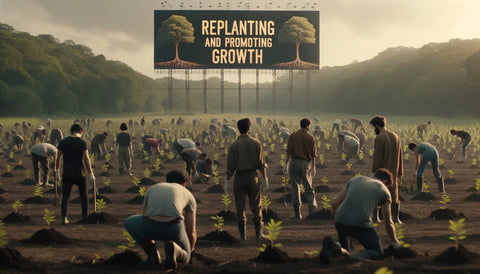What Is Sustainable Wood?
Sustainable wood is an important renewable resource that, when sourced responsibly, provides environmental and economic benefits compared to non-renewable materials like concrete, steel, and fossil fuels. As consumers become more eco-conscious, demand for ethically-sourced, eco-friendly wood products has grown significantly. But what exactly makes wood "sustainable"? Here, we'll explore what sustainable forestry entails, how wood is assessed for sustainability, and the complex issues around deforestation and importing wood.

Defining Sustainable Wood
So what exactly constitutes sustainable wood? Sustainable wood comes from forests that are managed to meet present timber needs without compromising future forest health or biodiversity. This involves continuously cultivating forests to provide an ongoing yield of wood resources, while conserving ecological integrity.
Specific criteria for sustainable wood include:
- Responsible harvesting - Trees are selectively cut using reduced impact logging methods that minimize damage to surrounding habitat. Cutting rotation cycles and intensity are set at sustainable levels allowing forests to regenerate.
- Replanting and growth - Logging activities are balanced with natural growth rates and active replanting to maintain healthy, productive forests. Targets are set for regeneration, growth and age class diversity.
- Protecting conservation values - Biodiversity, water resources, soil quality, and cultural heritage are safeguarded through conservation of key ecosystems, habitats and species.
- Resource efficiency - Operations maximize resource use efficiency, prevent waste, and utilize wood by-products.
- Socio-economic benefits - Workers are treated fairly and local communities benefit through stakeholder involvement, employment and resources.
- Compliance with laws - All applicable forestry laws, regulations and tenure rights are complied with.
- Third-party certification - Sustainable practices are verified through independent audits by certification bodies like FSC and PEFC.

Wood meeting these criteria provides confidence it comes from responsibly managed forests that will remain healthy and productive for generations to come. This sets sustainable wood apart from non-certified or illegal logging which can degrade forests long-term.
Why Is Sustainable Wood Important?
Sustainable wood sourcing and products are important for several key reasons:
Promoting Forest Health and Biodiversity
Sustainable forestry practices maintain the long-term health and biodiversity of forests. Selective cutting, replanting, and conservation of key habitats and species preserves vibrant, functioning forest ecosystems for future generations. This protects the many species that rely on forests for survival.
Combating Climate Change
Using wood for fuel, buildings, and products stores carbon absorbed by trees as they grow, keeping it out of the atmosphere. And sustainably managed forests actively remove carbon from the air. This makes wood a carbon-neutral, renewable alternative to fossil fuel-intensive materials like concrete and steel.
Supporting Local Economies
The sustainable forestry industry provides employment and resources for rural and indigenous communities worldwide. Eco-certification schemes include standards for worker welfare, indigenous rights, and sharing economic benefits with local populations. This helps provide sustainable livelihoods.
Reducing Waste and Pollution
Sourcing sustainable wood reduces demand for environmentally harmful logging. And using wood's natural properties in construction can decrease waste versus other materials. For example, engineered wood composites use scraps and sawdust. At end-of-life, wood is biodegradable and can be reused or repurposed.
How Is Wood Determined To Be Sustainable or Not?
With the rise in sustainability standards, several certification schemes now help determine if wood comes from responsibly managed forests:
Forest Stewardship Council (FSC)
The FSC is one of the most widely recognised sustainable forestry certifications globally. FSC certification involves:
- Annual audits and checks of legal compliance, sustainability practices, and social responsibility.
- Chain of custody tracking of certified wood from forest to final product.
- Multi-stakeholder involvement, including environmental groups.
Programme for the Endorsement of Forest Certification (PEFC)
Similar to FSC, PEFC is an international sustainable forestry certification that sets standards for:
- Protecting biodiversity, water, and soil quality.
- Safeguarding socio-economic wellbeing of workers and communities.
- Traceability and chain of custody protocols.
- Monitoring and assessment processes.
SFI & CSA Standards
The Sustainable Forestry Initiative (SFI) and Canadian Standards Association (CSA) standards take a similar approach for North American forestry certification. They emphasise sustainable harvesting, replanting, waste minimisation, and preservation of wildlife habitat.

Deforestation and Importing Wood
Despite certification schemes, deforestation remains an issue, often driven by clearing land for agriculture. And complex global supply chains can make tracing imported wood's origins difficult. This leads to key considerations around sourcing imported wood:
Legality and Transparency
Under laws like the UK Timber Regulation and EU Timber Regulation, companies must assess risk and ensure imported wood comes from legal sources. Robust due diligence, supply chain traceability and forestry certification help verify legality.
Impact on High Conservation Value Forests
Forests with exceptional cultural, ecological, or social value should be conserved. Certification standards like FSC prohibit wood from these forests. Companies must screen sources to ensure they do not impact intact primary or old-growth forests.
Evaluating True Sustainability
Even wood from legal, selectively logged forests can contribute to biodiversity loss and carbon emissions when not sustainably managed. Factors like a forest's previous condition, logging intensity, and replanting rates must be weighed when judging overall sustainability.
Prioritising Domestic Sourcing
In the UK, sourcing wood domestically from forests certified under UK Woodland Assurance Standard minimises transportation emissions. While imported wood has a place in supply chains, local sourcing provides greater transparency and aligns with net-zero commitments.
Ultimately, sustainable wood requires a holistic outlook. Responsible sourcing means going beyond legality to ensure harvesting aligns with forest health, conservation, and community well-being for generations to come. With careful stewardship and responsible practices, wood can provide a renewable, ethical building material and energy source.
Beyond Timber: Valuing Forests for Biodiversity and Ecosystem Health
Forests are complex, vibrant ecosystems that support a diversity of plant and animal life. They play a critical role in regulating climate, supporting indigenous communities, and providing renewable resources. However, extensive deforestation driven by agricultural expansion threatens many of the world’s remaining forests and their biodiversity. At the same time, wood remains an essential renewable material, and demand continues to grow. This brings the sustainability of forestry practices into sharp focus. When sourced ethically, wood can be harvested in balance with preserving forest health into the future.
The Value of Forest Ecosystems
Forests provide far more than just timber resources. Tropical, temperate and boreal forests contain over 80% of the world’s biodiversity on land, providing varied habitats for countless species. Iconic animals like orangutans, jaguars, wolves, and eagles rely on intact, interconnected forest ecosystems to survive. Beyond supporting wildlife, forests regulate climate through carbon sequestration, influence rainfall patterns, prevent soil erosion, and filter water supplies. They also hold deep cultural value for indigenous populations. Conserving the integrity of these ecosystems must be a priority.
Threats from Unsustainable Practices
Without proper safeguards, logging can severely degrade forests. Clearcutting and conversion of lands to agriculture are major drivers of deforestation, especially in developing tropical regions. Even selective logging, if not sustainably managed, can fragment habitats, erode soils, introduce invasive species, and disrupt ecological balance. A business-as-usual approach predicated on maximizing timber yields has spelled disaster for many forests. What is needed is a holistic model of forestry that balances conservation needs with wood production.
The Promise of Sustainable Forestry
Sustainable forestry offers a path to obtaining renewable wood resources without permanent damage to forest ecosystems. Through practices like selective harvesting, agroforestry, and forest regeneration, trees can be cultivated as a crop while retaining biodiversity and ecological functions. The Forest Stewardship Council (FSC) sets standards that ensure sustainable logging by requiring:
- Conservation of key ecosystems and species
- Protection of waterways, soils, and cultural sites
- Limited cutting rotations to allow regrowth
- Replanting and restoration measures
- Fair treatment of workers and engagement with local communities
Sourcing wood certified to these sustainability standards means it comes from responsibly managed forests, not those subject to harmful clearcutting or conversion. This provides an ethical alternative.
The Need for Holistic Solutions
Truly sustainable forestry must look at whole systems - from individual forest stands to global supply chains. While sourcing certified wood is important, reducing waste and prioritizing recycled material are also critical to reduce pressure on forests. Policy solutions like incentivizing sustainable practices, establishing protected areas, and curbing illegal logging can further help ensure balanced use of forest resources into the future. With eco-conscious consumer demand, government regulation, and industry leadership, forests and forestry can coexist through responsible stewardship. The preservation of these vital ecosystems depends on it.
Clean-Burning Sustainable Wood: A Guide to Eco-Friendly Firewood
As eco-conscious consumers seek renewable, low-emission wood fuels for heating and cooking, much confusion persists around what constitutes truly sustainable firewood. Not all wood burns the same. Hardwood vs softwood, moisture content, processing method, and source sustainability all significantly impact firewood's environmental footprint. Here, we examine what makes some wood better for clean, efficient burning, while supporting responsible forest stewardship.
Understanding Firewood Basics
Firewood is a popular source of heating and aesthetic warmth for many households. While it might seem straightforward, there are several nuances to consider to get the best out of your firewood. All wood has the potential to provide a clean and efficient burn, especially when it has been appropriately seasoned. However, there are some crucial distinctions between the different types of firewood that can impact their burning properties:
Hardwoods vs Softwoods
Hardwoods and softwoods differ not just in their physical properties but also in their burning characteristics. Hardwoods such as oak, beech, and birch are denser, making them ideal for long, warm burns. Their dense cellular structure means that they release more usable energy per cord, leading to hotter and longer-lasting fires. Additionally, they produce less smoke, which can be a significant advantage for indoor fires. On the other hand, softwoods like pine and cedar are lighter and contain more moisture and sap. These characteristics make them prone to producing more creosote and smoke. However, with proper drying and seasoning, softwoods can also provide an efficient burn.
Moisture Content
The moisture content in wood plays a vital role in determining its burning efficiency. Wet or unseasoned wood is likely to smolder rather than burn, producing an excess of smoke and leading to creosote buildup in chimneys, which can be a fire hazard. Kiln-drying is a popular method to reduce wood's moisture content to below 20%, ensuring a clean and hot burn. For those who prefer air-drying, it's essential to stack firewood in a way that allows air circulation and to cover it from rain. A seasoning period of 6-12 months is recommended before the wood is fit for burning.
Firewood Processing Method
The way firewood is processed can also influence its drying time and burning efficiency. Split firewood, due to its increased surface area, dries faster than rounds or whole logs. For those using modern wood stoves, uniformly sized logs ensure consistent and efficient burning. In contrast, older wood-burning appliances might be more forgiving and can accommodate more rustic chunks or traditional cordwood.
Sourcing Sustainable Firewood
As the global focus shifts towards sustainability, sourcing firewood responsibly is becoming crucial. Here are some guidelines to ensure you're making environmentally-conscious choices:
Look for Credible Certification
Eco-labels like FSC (Forest Stewardship Council) and PEFC (Programme for the Endorsement of Forest Certification) are third-party certifications that guarantee the wood has been sourced from forests managed with environmental and conservation concerns in mind. With increasing demand, certified firewood is becoming more accessible, especially in regions like the UK.
Support Local Forestry
Local sourcing is not just about supporting the local economy but also about reducing the carbon footprint associated with transporting firewood over long distances. By choosing firewood produced under stringent UK forestry standards, you're also ensuring sustainable forest management practices are upheld.
Avoid Unknown Origins
With global trade, firewood from unknown or dubious origins can find its way into the market. Such wood might be associated with illegal logging or deforestation. Sticking to domestically sourced, certified firewood ensures you're not inadvertently supporting harmful practices. Always verify the sustainability policies of your firewood provider.
Choose Responsible Species
Tree species vary in their growth rates and ecological impacts. In the UK, native species like oak, ash, and birch are often sourced more sustainably compared to imported exotic species, which might be linked to deforestation in their native regions. It's crucial that providers clearly identify the tree species and their origins, allowing consumers to make informed choices.
Recycled & Waste Wood
In the wood industry, there are often leftovers and offcuts that might be deemed unsuitable for primary products. Using these remnants for firewood is an excellent way to ensure no part of the tree goes to waste. This practice not only maximizes resource efficiency but also diverts potential waste from landfills, promoting a circular economy.
The Future of Sustainable Firewood
Eco-friendly firewood offers a renewable, low-carbon heating solution when sourced responsibly. Supporting ethical providers committed to sustainable practices makes a real difference. As certification and local forestry programs expand, supply chains will continue improving. With some research and care when purchasing, consumers can feel confident their firewood comes from forests managed to endure for future generations.

Carbon Neutrality and the Path to Sustainable Wood
In the fervour to combat climate change, the quest for carbon neutrality has become a pivotal endeavour for businesses, governments, and individuals alike. As we turn our gaze toward sustainable solutions, wood, and specifically sustainable wood, emerges as a central figure in this narrative. As a UK-based entity, we are uniquely positioned to understand the intersection of these topics, the impact they have on our communities, and the vast potential they unlock.
Understanding Carbon Neutrality
To truly appreciate the importance of sustainable wood, we first must comprehend the concept of carbon neutrality. At its core, carbon neutrality means balancing the amount of carbon dioxide emitted into the atmosphere with an equivalent amount of carbon offset or removed from the atmosphere. The end goal? To ensure that our activities produce net-zero carbon emissions.
Given that the UK's commitment to achieving net-zero carbon emissions by 2050, it's evident that this isn't a fleeting trend. It's a pledge to our planet and future generations.
Sustainable Wood: The Green Gold
Wood, in its very essence, is carbon captured from the atmosphere. Trees absorb CO2 during their growth, sequestering carbon and releasing oxygen. When we talk about sustainable wood, we're referring to timber harvested responsibly from forests that are sustainably managed. These forests are rejuvenated after harvesting, ensuring a continuous cycle of growth and carbon absorption.
Economic Implications
Sustainable wood isn't just an environmental boon; it has significant economic implications too. The UK timber industry is worth billions of pounds, supporting countless jobs and communities. Investing in sustainable wood ensures a resilient and thriving industry for the foreseeable future. Moreover, as demand grows for eco-friendly products, businesses leveraging sustainable wood can expect a competitive edge in the marketplace.
Environmental Impact and Benefits
Forests play a vital role in maintaining our planet's ecological balance. Beyond carbon sequestration, they protect biodiversity, maintain water cycles, and offer shelter to countless species. Sustainable forestry ensures that these benefits remain intact. In contrast to clear-cutting or illegal logging, sustainable practices focus on selective harvesting, allowing forests to regenerate, maintain their ecological functions, and continue their vital role as our planet's lungs.
The Connection to Carbon Neutrality
With every piece of sustainably harvested wood, we make a tangible impact on carbon neutrality. Consider this:
- Carbon Storage: Every cubic metre of wood stores approximately one tonne of CO2.
- Reduction in Carbon-Intensive Materials: Wood can often replace materials like steel, concrete, or plastic, which have higher carbon footprints.
- Energy Consumption: Wood requires less energy in its processing compared to other building materials, further reducing carbon emissions.
Research has shown that kiln-dried wood, for instance, offers efficient combustion, ensuring that less carbon is emitted for every unit of energy produced. By prioritising such products, we inch closer to our carbon neutrality goals.
Challenges and the Road Ahead
While the promise of sustainable wood is undeniable, challenges persist. Supply chains need rigorous monitoring to ensure the wood's provenance. Additionally, a unified definition of what constitutes 'sustainable' is essential, paving the way for universal standards and certifications.
Yet, with challenges come opportunities. Technological advancements and innovative practices, from kiln drying techniques to improved forest management systems, herald a new era of sustainability.
Embracing Sustainable Wood for a Carbon-Neutral Future
As we stand on the brink of ecological change, sustainable wood offers a bridge to a more resilient and carbon-neutral future. It intertwines the promise of economic prosperity with environmental stewardship. As we navigate this journey, every choice we make, every piece of timber we utilise, and every sustainable practice we champion takes us one step closer to a harmonious balance with our planet. The path to carbon neutrality is paved with the choices we make today, and in sustainable wood, we find an ally for a brighter, greener tomorrow.
Energy Efficiency and Sustainable Firewood Logs
As the world shifts to more sustainable practices, our approach to energy consumption demands a parallel evolution. Here, in the heart of the UK, the question of energy efficiency isn't merely academic—it's integral to our collective future. One area that often remains overlooked is the humble firewood log, a cornerstone of British warmth for generations.
The Majesty of Kiln-Dried Wood
Perhaps no other wood represents the intersection of energy efficiency and sustainability as kiln-dried wood. When compared to its counterparts, kiln-dried wood offers a superior burning experience. Why? As the moisture content is reduced, it burns hotter and longer. But that's just the beginning.
Benefits of Kiln-Dried Wood
- Burn Duration: Kiln-dried ash and oak, for instance, offer extended burn times. Not only does this provide warmth, but it also means fewer logs are consumed.
- Economic Advantages: In the long run, less wood usage translates to monetary savings. As we've explored in our detailed analysis, investing in kiln-dried logs is not just an environmental choice but an economical one.
- Health Considerations: The reduced moisture content in kiln-dried wood means fewer pollutants are released when burning. This results in a healthier environment for you and reduced emissions for our planet.
The Sustainable Charm of Charcoal
While we cherish our logs, charcoal, especially the Gower charcoal and lumpwood charcoal, deserves a mention. With its origins tracing back centuries, lumpwood charcoal is making a significant resurgence, and for good reasons.
The Lumpwood Revolution
Organic Lumpwood Charcoal: Enhanced Taste and Quality
As any chef will attest, using restaurant-grade charcoal offers an unmatched flavour profile, taking barbecues to the next level.
Lumpwood Charcoal & Sustainability
Modern lumpwood is produced with eco-friendly practices. We've delved deep into reviving lost grilling techniques to ensure our lumpwood charcoal isn't just efficient but sustainable.
The Magic of Swedish Fire Logs
Among our beloved products, the Swedish fire logs, candles, and torches stand out not just for their aesthetic appeal but their eco-consciousness. These products are crafted with care, ensuring minimal environmental impact while maximising utility. Perfect for parties and gatherings, they provide warmth, light, and a touch of magic to any event.
Proper Storage: Ensuring Wood Longevity
Any discourse on sustainability is incomplete without addressing storage. Proper storage not only ensures wood longevity but also maintains its quality. It's imperative to know how much firewood you'll need for the winter and understand the dos and don'ts of storing kiln-dried logs.
The Road Ahead
The journey towards a sustainable future is a shared one. By opting for energy-efficient firewood and sustainable practices, we're not just saving pennies; we're investing in a brighter, cleaner tomorrow. As we navigate these paths, we remain committed to providing you with the best products, informed insights, and a warmer, brighter future. Together, let's kindle the flames of change.

Sustainable Wood: The Unsung Hero of Cleaner Air Quality
Sustainable forestry, or the practice of managing and using forests in ways that preserve their biodiversity, productivity, and ecological processes, is more than just a catchphrase or buzzword. It's a commitment to ensuring the longevity of our forests and the myriad benefits they provide. One such benefit, often overlooked, is the direct connection between sustainably harvested wood and improved air quality. Let's delve deeper into this connection.
The Carbon Cycle: A Brief Primer
To understand the significance of sustainable wood in air quality, it's vital to comprehend the basics of the carbon cycle. Trees play a pivotal role in this cycle. As they grow, they absorb carbon dioxide (CO₂) from the atmosphere, converting it into oxygen through photosynthesis, and storing carbon in their trunks, branches, and roots. This natural process effectively 'locks away' vast amounts of carbon, mitigating the effects of greenhouse gases and providing us with the air we breathe.
1. Sustainable Forestry and Carbon Sequestration
We, in the UK, are blessed with abundant forests that serve as major carbon sinks. When forests are managed sustainably, they continue to absorb and store carbon in large quantities. Moreover, when wood from these forests is harvested and used in long-lasting products, such as timber for construction or furniture, the carbon remains 'trapped' within those products for their lifespan. In effect, we're prolonging the carbon storage capability of that piece of wood.
Compare this with non-sustainably managed forests where excessive logging, clear cutting, or poor management practices can release stored carbon back into the atmosphere, exacerbating our climate issues.
2. Air Quality Benefits Beyond Carbon Sequestration
But the benefits of sustainable wood don’t stop at carbon sequestration. Consider the alternatives: materials like steel, concrete, and plastics have a significantly higher carbon footprint than timber. These alternatives require vast amounts of energy during production and often release a plethora of harmful emissions.
Using sustainably sourced timber reduces our reliance on such high-carbon alternatives. It’s a simple yet effective way to ensure that the materials we utilise are contributing to cleaner air and a healthier planet.
3. The Economic Upside of Sustainable Wood
While our primary focus is on environmental benefits, it’s worth noting that sustainable forestry and wood production also provide economic incentives. The sustainable timber industry in the UK supports thousands of jobs, from foresters and loggers to carpenters and architects. And, as the demand for environmentally friendly products rises, the value of sustainable wood, both domestically and on the global market, sees an upward trajectory.
By investing in sustainable forestry, we're not only preserving our natural heritage but also ensuring that the UK remains at the forefront of green industries.
4. Healthy Forests: A Natural Air Filter
Beyond their role in the carbon cycle, forests act as natural air filters. Trees absorb a wide range of pollutants, including harmful ones like sulphur dioxide, ammonia, and nitrogen oxides. They effectively cleanse the air, making it healthier for all of us to breathe.
In sustainably managed forests, this capacity is maximised. The diverse mix of tree species, along with the controlled, thoughtful harvest of timber, ensures that the forest remains healthy and vibrant, continuing to serve its role as a natural air purifier.
A Sustainable Future is a Breath of Fresh Air
As we face global challenges related to climate change and pollution, it's easy to feel overwhelmed. However, by focusing on practices like sustainable forestry and choosing sustainable wood products, we have an accessible, effective tool at our disposal.
The choice is clear. By committing to sustainable wood, we're not just investing in a material. We're championing a future where the air is cleaner, our forests thrive, and the UK continues to lead in environmentally conscious practices.

Sustainable Wood: Nurturing Forests and Supporting Ecosystems
Wood is one of humanity's most versatile and valued natural resources, providing materials for everything from homes to furniture to paper. However, unsustainable forestry practices have long contributed to deforestation, habitat loss and climate change through uncontrolled logging and clearing of ancient forests. The concept of sustainable wood aims to fundamentally change this relationship between forests and human societies, redefining wood as a renewable crop that can be cultivated while respecting ecological limits and preserving vibrant forest ecosystems.
Sustainable Forestry Practices
Sustainable forestry is the harmonious integration of environmental, economic, and social values, ensuring that forests retain their ecological importance while simultaneously benefiting communities and industries. Its core principle revolves around stewarding the health of the entire forest ecosystem, rather than merely focusing on maximizing timber yields for short-term gains.

Responsible Harvesting
-
Using reduced impact logging methods: Such methods are specifically designed to minimize the harm to surrounding habitats and the soil. This includes techniques like directional felling, where trees are cut in such a way that they fall in a predetermined direction to reduce damage to surrounding trees.
-
Setting sustainable allowable cut levels and cutting rotation cycles: This ensures that harvested volumes do not exceed the forest's capacity to regenerate. Adhering to these cycles guarantees that trees are given adequate time to mature before they are felled, mirroring natural growth rates and patterns.
-
Mapping and protecting areas of high conservation value: These are zones within forests that have an especially rich biodiversity or possess rare species. Identifying and protecting them helps conserve the ecological balance of the entire forest.
Replanting and Promoting Growth
-
Prompt natural regeneration or active replanting of harvested areas: Once an area is harvested, it's essential either to allow it to regenerate naturally or actively intervene by planting native tree species. This ensures the forest's continuity and health.
-
Thinning dense stands: Over time, some forest areas can become excessively dense, which stifles tree growth. Thinning such regions ensures trees have adequate sunlight, water, and nutrients.
-
Retaining dead snags and downed wood: These play a crucial role in the forest ecosystem, offering habitats for various species and gradually decomposing to enrich the soil with organic matter.
Connecting Forest Habitats
-
Designating wildlife corridors: These are designated areas that allow animals to traverse between distinct habitats, maintaining genetic diversity and preventing inbreeding. They're especially vital in today's fragmented landscapes.
-
Leaving riparian buffer zones: These are areas around wetlands and waterways left undisturbed by logging activities. They serve as filters for pollutants and ensure the health of aquatic ecosystems.
Supporting Biodiversity
-
Conserving rare species: This doesn't just involve animals but also extends to various unique and rare varieties of native plants and fungi.
-
Protecting and restoring habitats: This specifically targets endangered wildlife, ensuring their survival and, by extension, the health of the broader ecosystem.
Benefits for Ecosystems and Communities
Adopting sustainable practices has broader implications beyond the immediate health of the forest.
Climate Regulation
Forests, when responsibly managed, function as vital carbon sinks. As trees grow, they absorb and sequester CO2 from the atmosphere. In doing so, they play an essential role in offsetting the greenhouse gas emissions that drive global warming.
Watershed Protection
Intact, thriving forests are pivotal in stabilizing soils, which prevents erosion. Moreover, the rich forest soil acts as a natural filter for rainwater, ensuring runoff is clean. Through these mechanisms, forests play an indispensable role in maintaining water supplies for countless communities.
Wildlife Habitat
Forests are not merely collections of trees. They're intricate, interconnected habitats that house a myriad of organisms, from the smallest fungi and insects to large mammals and birds. Ensuring their health guarantees genetic diversity, which is vital for the resilience of ecosystems.
Economic Opportunities
Transitioning to sustainable forestry opens avenues for local communities. Local workers can be involved in the entire chain, from harvesting to processing sustainable wood. This shift is part of the emerging green economy, emphasizing conservation and sustainable resource management.
The Broader Ecological Concerns of Sustainable Forestry
By emphasizing the broader ecological picture over mere extraction, sustainable forestry aims to satisfy our wood product needs without sacrificing the health and vibrancy of our forests. Third-party certifications play an essential role in this, offering a verifiable assurance that products originate from ethically and responsibly managed sources. With such conscientious stewardship, it's entirely possible for forests and humanity to enjoy mutual prosperity.
